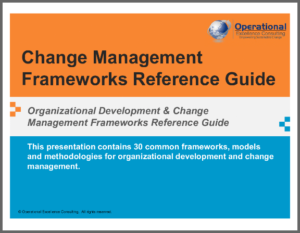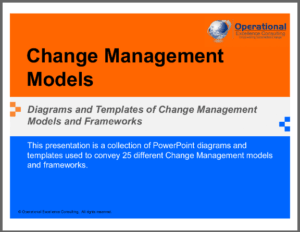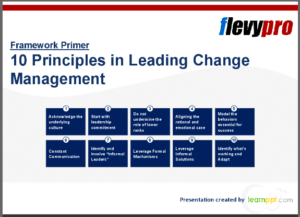The Elisabeth Kubler-Ross Change Curve has come to be widely accepted as a model for the stages of change. It provides a useful perspective that is helpful in identifying where people are on their change journey.
This post explains the Kubler-Ross Change Model, explores its foundation, identifies strengths of the model, and identifies how strategists and project managers can apply it in practice.
What Is the Kubler-Ross Change Model?
The Kubler-Ross Change Model, also known as the Change Curve, provides a mind-expanding perspective on what people go through in the process of any change. Elisabeth Kubler-Ross goes deep into the meaning of grief in “On Grief and Grieving: Finding the Meaning of Grief Through the Five Stages of Loss“.
Here are descriptions of each phase – which you may recognize from personal experience:
- Shock – This stage is a matter of processing what has happened. People resist ‘engaging’ with the change, and try to hold it at arm’s length. They observe it…and debate whether it is real or a figment of their imagination. Morale and Confidence initially increase like an adrenaline rush.
- Denial – A person’s internal ‘fight’ may bubble to the surface as they raise their energy level to battle with the intruding change. They are still holding onto hope that it may not be true. Morale and Confidence begin to decline.
- Frustration – When they see that the battle of denial is going nowhere, a type of acceptance sets in where they turn their attention to someone or something to blame – even themselves. They are angry and frustrated. Morale and Confidence decline further.
- Depression – In spite of the frustration, they may hold on to a false hope that things will not change…but eventually they even lose hope in that. Morale and Confidence hit their low point.
- Experiment – With a new resolve, the person begins to engage with their situation. They shift from a more emotional response to a more rational and realistic one. They begin to Experiment with ways to cope with the new situation. Morale and Confidence begin to grow in this stage.
- Decision – Having experimented with ways to cope, the person arrives at a decision on how they will move forward. They shift into ‘action mode’ and get to work on their new situation. Morale and Confidence grow at an accelerated pace.
- Integration – In this last stage, a person feels as if they have made it through the process. They have processed, experimented, and built ways to cope with the change. They have renewed themselves and have found a ‘new normal’. Morale and Confidence continue to grow at a more stabilized pace.
 It is notable that Stages 1 through 4 are totally emotional, where Stages 5 through 7 are very rational. The strategy for managing through these stages is driven by the need to either handle emotions or appeal to rationality.
It is notable that Stages 1 through 4 are totally emotional, where Stages 5 through 7 are very rational. The strategy for managing through these stages is driven by the need to either handle emotions or appeal to rationality.
These 7 stages of the Kubler-Ross Change Curve gradually came to be accepted as a valid approach to any process of change, including in large organizations. However, the change curve model was derived from an original 5-stage model.
Roots of the Curve: Elisabeth Kubler-Ross 5 Stages of Grief
 Elisabeth Kubler-Ross wrote “On Death and Dying” in 1969, inspired by her work with people who were terminally ill.
Elisabeth Kubler-Ross wrote “On Death and Dying” in 1969, inspired by her work with people who were terminally ill.
The 7-step Kuber-Ross Change Model, or Change Curve, has its roots in what became known as ‘the 5 stages of grief’, or ‘the 5 stages of death’, or ‘the 5 stages of loss’, or simply ‘the 5 stages’:
- Denial – Someone might exclaim, “I cannot believe this is happening to me!” Temporary Denial means that the person is shocked by some sudden change, and they need time to process it.
- Anger – Someone might say, “Why did this happen to me?!” as an expression of anger. This is an indication that they have moved past Denial, acknowledge what has happened, and now are Angry about it.
- Bargaining – People switch modes once they have at least partially gotten control of their Anger. They switch gears to trying to find solutions, even if temporary. They many say, “I will give you anything you want if you just give me more time.” This can apply to death…or keeping a job – and provides hope.
- Depression – Situations can reach a point where they seem hopeless. It could be a manufacturing plant closing, a favored politic candidate losing an election, or a person facing death. As people lose hope, they may say things like, “What’s the point in trying…and I don’t have the energy to try anyway.”
- Acceptance – Change is difficult, but if a person can Accept it, they can change gears and begin to prepare for it, and build a new hope that everything will be alright. They might say, “This is tough, but I can get through it. Let me see what I can do to prepare and make everything turn out OK.”
 This 5- stage process is highly personal. And it is not linear; people can and often do turn back to prior stages and get through the whole continuum in a somewhat erratic way. Everyone can experience it and go through the stages differently…but they will go through the stages as part of their emotional journey.
This 5- stage process is highly personal. And it is not linear; people can and often do turn back to prior stages and get through the whole continuum in a somewhat erratic way. Everyone can experience it and go through the stages differently…but they will go through the stages as part of their emotional journey.
The 5-stage process is not so much a process that you can follow, but rather a process to understand where a person is in their experience of grief or change.
The work of Elisabeth Kubler-Ross is remembered and continues through the Kubler-Ross Foundation.
Strategy and the Kubler-Ross Change Curve
For thinking about strategy, the Kubler-Ross Change Curve is useful as a predictor of what might happen in the face of change. It is useful and necessary to frameworks like this in plans for strategic changes.
—————————————-
I recommend these strategy resources on FlevyPro (paid links):
| Change Management Frameworks Reference Guide 402-slide PowerPoint deck $179.00 |
Change Management Models 136-slide PowerPoint deck $59.00 |

|

|
| 10 Principles in Leading Change Management 17-slide PowerPoint deck $25.00 |
Lean Change Management 21-slide PowerPoint deck $25.00 |
 |
 |
—————————————-
While strategic changes might not be so emotional as depicted in the Kubler-Ross curve, there are instances where that could be the case.
Strategists need to be mindful of the impact of change and plan implementation accordingly. Strategic initiatives that might consider this include:
- Best Practice Initiatives – Where systems are implemented to streamline and lower costs for the organization to achieve competitive advantage, strategists need to be aware of the impact of the changes on people. Where systems are long-standing in well-established businesses, the impact of the changes could be considerable.
- Business Model Shifts – Where elements of business models are adjusted, or there are wholesale shifts through business model innovation, strategists need to consider the capabilities and readiness of people and the organization for change.
- Technology-driven businesses – Technology is constantly changing, and technology businesses will be especially subject to change. Such businesses commonly are transforming themselves on the fly – like a lean innovation process – in response to rapid learning and market responses. Typically, people in these situations will be oriented to this, but the capacity to change needs to be considered.
- Cultural shifts on established companies – Sometimes business models are completely upended. For example, the application of Internet of Things (IoT) technology to existing non-digital products tends to revolutionize products. Strategists need to consider who the stakeholders are and what changes they will face when laying out the strategy.
The effect of changes on people is a critical implementation impact that strategists need to consider.
Project Management and the Kubler-Ross Change Model
 The human emotional side of change is a critical consideration for project managers.
The human emotional side of change is a critical consideration for project managers.
Projects are all about changes of some sort. It is most important to known how to handle change at different points in the change process. The Kubler-Ross Change Curve can provide some guidance for this as change initiatives are executed.
Often project managers take a very rational approach to solving problems and managing projects. It is probably the nature of the field, and PM’s are charged with delivering the benefits of the projects.
However, when change is involved – and it usually is to some degree – it pays to tailor your management actions to the phase of change that seems to be taking place.
- Taking an Emotional Approach – As the first four phases of the Kubler-Ross Change Curve are completely driven by emotions – Shock, Denial, Frustration, and Depression – it makes sense to tailor the response to those emotions. First, you can help people through it by raising their awareness of these phases. Much can even be accomplished in advance, before the change even happens, so that people can mentally and emotionally prepare for it. A collaborative approach of creating support systems among team members and employees can help them to help themselves.
- Taking a Rational Approach – The last three phases of the Change Curve – Experiment, Decision and Integration – are much more rationally driven. People have essentially gotten over the emotional side of the change and their focus is on taking action and moving forward. In managing through these phases, you will be able to focus more on tasks, scheduling, and metrics.
Since the stages of the Kubler-Ross Change Curve are not necessarily linear, you may need to shift between the emotional and rational approaches. This may also be required in parts of the organization or with individual people. Be aware of the difference, and be prepared to shift between approaches.
—————————————-
I recommend these PM templates (paid link):

—————————————-
Note that forward-thinking management and strategic approaches can shift the configuration of the curve so that people adapt to the change more quickly, with less pain, and at lower cost.
Advantages and Disadvantages of the Kubler-Ross Change Curve
 There are some strengths and shortcomings to the Kubler-Ross Change Curve as a tool. However, I find that they are manageable, if you are aware.
There are some strengths and shortcomings to the Kubler-Ross Change Curve as a tool. However, I find that they are manageable, if you are aware.
Advantages
- Based on observations – Both the 5 stages of grief and the 7 stages of the Change Curve were driven by observations independent of any affiliations, industries, or organizations.
- Natural reactions – The curve is based on natural and consistent reactions of people.
- Universally applicable – The Change Curve has been adapted for application to any type of change.
- Common sense – The Curve and the concepts are easy to apply to real life situations.
Disadvantages
- Not prescriptive – Unlike other change management models, such as Kotter’s 8 Steps, the Kubler-Ross Change Curve helps identify where people are in the change journey, which informs how to manage the situation.
- Actions need to be tailored – Since the stages are not sequential, people often shift between stages, and they do not always react in the same way. Management approaches need to be tailored to the situation.
It is important to note that not every manager will be suited to manage optimally at every stage of change. It can be beneficial to assemble a management team with complementary skills.
Conclusion and Further Resources
Change is complicated, and the Kubler-Ross Change Model can help anyone understand the natural stages that people go through on any change journey.
Do you have a change journey that you can share, and how did the journey map to the Kubler-Ross Change Curve?
For a deep dive into the meaning of grief through the studies of Kubler-Ross, see “On Grief and Grieving: Finding the Meaning of Grief Through the Five Stages of Loss” by Elisabeth Kubler-Ross and David Kessler.
For a good video with additional perspective, see “The Change Curve” by Expert Program Management (EPM):